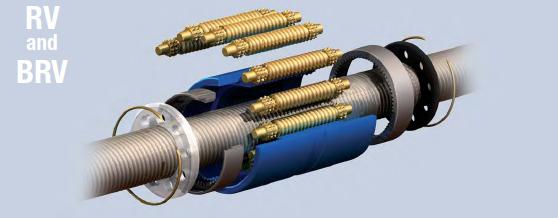Roller screws
Roller screws have three main parts, the screw, the nut and the rollers that transmit motion and force from the screw to the nut or from the nut to the screw. Roller screws convert:
- rotary motion and force into linear motion and force
- linear motion and force into rotary motion and force.
When the screw is rotated, the nut travels along the screw.
When the nut is rotated, the screw travels through the nut.
Rollers are used between the screw and nut because they create less friction than a nut and screw that are in direct contact. Rollers can support very heavy loads because of the large number of points of contact. The rollers have a gear at each end which mesh with ring gears. The ring gear keeps the rollers aligned along the screw correctly.

Image courtesy of ROLLVIS SA www.rollvis.com
The nut assembly may consist of a single nut, a split nut or a double nut. The use of a single nut results in a small amount of backlash between the nut and the screw. Backlash is the small amount of forward and backward longitudinal or axial movement between the screw and a nut caused by the spaces between the screw threads.
Split nuts have a spacer between the two halves of the nut. The two halves are clamped together by screws to eliminate backlash and so increase accuracy.
Roller screws are also called planetary roller screws and satellite roller screws because rollers orbit the screw. Roller screws are classified as actuators because they transmit motion and force and convert rotary motion into linear motion and vice versa.
YouTube video courtesy of Rollvis SA, www.rollviz.com
The satellite roller screws catalogue by ROLLVIS SA has detailed descriptions and clear illustrations of roller screws. To view the ROLLVIS SA Satellite Roller catalogue please go to: http://www.rollvis.com/EN/resources/Rollvis-2013-EN.pdf
|

